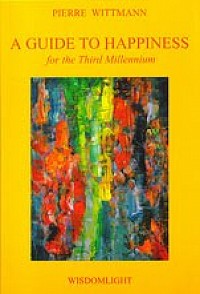A GUIDE TO HAPPINESS
A Guide to Happiness for the Third Millennium
Pierre Wittmann
Wisdomlight, 2003
21 x 14 cm, 262 pages
ISBN 974-91154-0-6
Presentation
The author takes us on a journey through his artistic activities and his daily experiences, his esoteric readings and his spiritual practices, his reflections on the world of today and his visions for the world of tomorrow. He encourages us, with humour and wisdom, to observe the circumstances of our life and the structures of society, in order to understand the present and to use it to create the future.
While travelling through the seventy stages of this journey, you will explore, to name a few, Buddhism, Taoism, Reiki, astrology, Angelic Healing, meditation, extra-sensory art, golf, personal development, Feng Shui, homeopathy… You will discover their principles and benefits presented in a clear and concise way.
Some excursions will allow you to grasp the nature of the deep transformations that mark our time; and the stopovers will incite you to undertake a personal process to participate in the birth of a new world.
Along the way, you will practice laughter, kindness, forgiveness, simplicity, gratitude, love, wonder… and you will learn to use daily situations to attract happiness into your own life and to offer it to others.
This guide addresses the beginner on the path of wisdom and happiness as well as the mature disciple.
Three Kinds of Information
In A Guide to Happiness for the Third Millennium, Pierre Wittmann takes us on a journey, in seventy stages, on the path to happiness. Each chapter presents a topic related to the search for happiness. The happiness that this book invites us to discover is inner happiness – peace and harmony – not only for ourselves, but for the whole of society.
Explanations of the nature of happiness and suffering – of health and illness – on the individual, social and global levels. These include understanding our present situation, visions for the future, and suggestions on the means of transformation. Among these topics, you will find: What Truth Should We Believe, Working for Peace, The Price of Happiness, War and Peace, The New Paradigm, Science and Spirituality, Manipulation through Suffering, Crises and Transformation, The Ills of Society, and A New World.
Brief introductions to teachings of wisdom that relate to our understanding of the nature of reality, our view of the world, our beliefs and our values. You will discover the principles and benefits of various spiritual teachings presented in a clear and concise way. You will also find Buddhist teachings, such as Impermanence, Non-Self, The Perfections and The Divine Emotions; Wu-Wei, or Non-Action, a Taoist teaching; Homeopathy, Reiki and Angelic Healing; Extra-Sensory Art, Light Structures and The Platonic Solids; Astrology, Feng Shui, and The Enneagram.
Practical techniques that use daily situations to attract happiness into our life and to offer it to those close to us, including Forgiveness, Meditation, Laughter, Beauty, Prayer, The Emotions, Gratitude, Kindness, Wonder, Peace, Nature, The Pages, Knowing How to Connect…
These three kinds of information are not arranged separately, but interweave, in order to instil in you one of the most important truths that allows one to reach the realisation of happiness, interconnection. All is linked, and our impression that we are separate beings is an illusion. It is the cause of most of our suffering and our frustrations.
Essential Points
Here is a summary of some of the essential points discussed in A Guide to Happiness:
The Truth. How to recognise what is true in all the information that we receive; how to become conscious of the conditioning and manipulation to which we are all prey; and how to continue to live in the world while disengaging from the structures and influences that stress and exhaust us.
The Emotions. Among the different types of emotions, some are beneficial to our physical and mental health and for our relationships with others, whereas others are particularly harmful to all aspects of our life. One can learn to recognize these and to manage them.
Microcosm and Macrocosm. There are different levels of reality that are intimately interconnected and that reflect in each other, from the atom and the cell, to the galaxy and the universe, while passing through the organs, living beings, social groups, ecosystems, the planets and the stars.
Responsibility. Understanding the situations of our life, the way we react to what happens to us, and accepting responsibility for everything that happens to us, helps us to stop being victims and to discover the power to create the existence to which we aspire.
A New World. What is the nature of the changes and transformations we can expect in the coming years or decades, and what will be the nature of the new world that will result from them?

